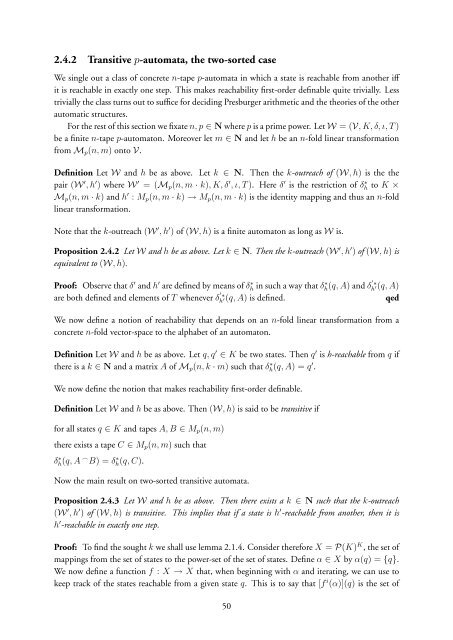On the methods of mechanical non-theorems (latest version)
On the methods of mechanical non-theorems (latest version)
On the methods of mechanical non-theorems (latest version)
Create successful ePaper yourself
Turn your PDF publications into a flip-book with our unique Google optimized e-Paper software.
2.4.2 Transitive p-automata, <strong>the</strong> two-sorted case<br />
We single out a class <strong>of</strong> concrete n-tape p-automata in which a state is reachable from ano<strong>the</strong>r iff<br />
it is reachable in exactly one step. This makes reachability first-order definable quite trivially. Less<br />
trivially <strong>the</strong> class turns out to suffice for deciding Presburger arithmetic and <strong>the</strong> <strong>the</strong>ories <strong>of</strong> <strong>the</strong> o<strong>the</strong>r<br />
automatic structures.<br />
For <strong>the</strong> rest <strong>of</strong> this section we fixate n, p ∈ N where p is a prime power. Let W = (V, K, δ, ι, T )<br />
be a finite n-tape p-automaton. Moreover let m ∈ N and let h be an n-fold linear transformation<br />
from M p (n, m) onto V.<br />
Definition Let W and h be as above. Let k ∈ N. Then <strong>the</strong> k-outreach <strong>of</strong> (W, h) is <strong>the</strong> <strong>the</strong><br />
pair (W ′ , h ′ ) where W ′ = (M p (n, m · k), K, δ ′ , ι, T ). Here δ ′ is <strong>the</strong> restriction <strong>of</strong> δ ∗ h to K ×<br />
M p (n, m · k) and h ′ : M p (n, m · k) → M p (n, m · k) is <strong>the</strong> identity mapping and thus an n-fold<br />
linear transformation.<br />
Note that <strong>the</strong> k-outreach (W ′ , h ′ ) <strong>of</strong> (W, h) is a finite automaton as long as W is.<br />
Proposition 2.4.2 Let W and h be as above. Let k ∈ N. Then <strong>the</strong> k-outreach (W ′ , h ′ ) <strong>of</strong> (W, h) is<br />
equivalent to (W, h).<br />
Pro<strong>of</strong>: Observe that δ ′ and h ′ are defined by means <strong>of</strong> δh ∗ in such a way that δh(q, ∗ A) and δ ′ ∗<br />
h ′(q, A)<br />
are both defined and elements <strong>of</strong> T whenever δ ′ ∗<br />
h ′(q, A) is defined.<br />
qed<br />
We now define a notion <strong>of</strong> reachability that depends on an n-fold linear transformation from a<br />
concrete n-fold vector-space to <strong>the</strong> alphabet <strong>of</strong> an automaton.<br />
Definition Let W and h be as above. Let q, q ′ ∈ K be two states. Then q ′ is h-reachable from q if<br />
<strong>the</strong>re is a k ∈ N and a matrix A <strong>of</strong> M p (n, k · m) such that δ ∗ h(q, A) = q ′ .<br />
We now define <strong>the</strong> notion that makes reachability first-order definable.<br />
Definition Let W and h be as above. Then (W, h) is said to be transitive if<br />
for all states q ∈ K and tapes A, B ∈ M p (n, m)<br />
<strong>the</strong>re exists a tape C ∈ M p (n, m) such that<br />
δ ∗ h(q, A ⌢ B) = δ ∗ h(q, C).<br />
Now <strong>the</strong> main result on two-sorted transitive automata.<br />
Proposition 2.4.3 Let W and h be as above. Then <strong>the</strong>re exists a k ∈ N such that <strong>the</strong> k-outreach<br />
(W ′ , h ′ ) <strong>of</strong> (W, h) is transitive. This implies that if a state is h ′ -reachable from ano<strong>the</strong>r, <strong>the</strong>n it is<br />
h ′ -reachable in exactly one step.<br />
Pro<strong>of</strong>: To find <strong>the</strong> sought k we shall use lemma 2.1.4. Consider <strong>the</strong>refore X = P(K) K , <strong>the</strong> set <strong>of</strong><br />
mappings from <strong>the</strong> set <strong>of</strong> states to <strong>the</strong> power-set <strong>of</strong> <strong>the</strong> set <strong>of</strong> states. Define α ∈ X by α(q) = {q}.<br />
We now define a function f : X → X that, when beginning with α and iterating, we can use to<br />
keep track <strong>of</strong> <strong>the</strong> states reachable from a given state q. This is to say that [f i (α)](q) is <strong>the</strong> set <strong>of</strong><br />
50
















